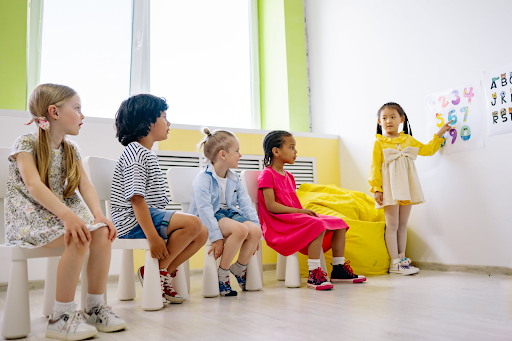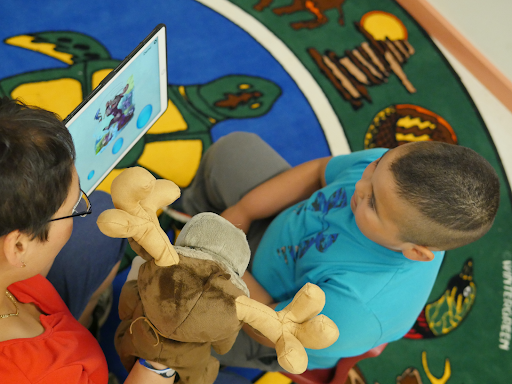In school districts across Canada and the US, there is a standardized assessment delivered at the end of grade 3 or grade 4 which often represents the first standardized assessment in the early years.
It also often marks the end of the primary school years.
But in fact, a lot of the time, early childhood education begins with an assessment!
Sprig Learning designs holistic assessments and creates early learning resources that raise the quality of education in pre-K to 3.
By holistically assessing every young student in the early stages of their education, it’s possible to gather the insights needed to improve student outcomes and enrich the learning experience for all students.
The Prevalence of the Early Childhood Assessment

In this table from the Education Commission of the States, we see that not all states have mandatory kindergarten entrance assessments.
The states that do mandate such assessments, have diagnostic screenings or readiness assessments that are either developed or approved by the department of education.
35 out of the 37 states who use kindergarten entry assessments (KEA) say that the data gathered is used to inform instruction.
The following details are provided for the recommended uses of KEAs.
- Identify students in need of remediation, intervention and/or enrichment.
- Develop a school readiness plan for each student.
- Identify and provide intensive instruction to students with reading deficiencies.
That is the extent of specificity in detailing how the KEAs are to be used.
As a result, according to the National Institute for Early Education Research, there are many educators who find these assessments “overly burdensome with inadequate content to successfully inform teaching”.
Early childhood assessments need to be easily administered to students and include high-quality content that informs classroom instruction.
Content and structure are the themes of recommendations in the following sections.
Considerations in Early Childhood Assessment

The National Association for the Education of Young Children (NAEYC) says that “developmentally appropriate assessments can provide the information needed to strengthen high-quality early childhood programs and early elementary programming.”
NAEYC recommends that rather than early childhood assessments being used solely as screening tools, they should also be used to inform pre-K and kindergarten programs, curricula and individual instruction.
There is consensus that early childhood assessments should be conducted in a classroom setting. It should be conducted formatively, using everyday work and behaviour.
The Learning Policy Institute recommends that high-quality early childhood assessments:
- measure essential domains of child development in ways that are developmentally appropriate and culturally relevant.
- connect to formative assessment across preschool to grade 3.
- have administration procedures that are fair for all children and practical for teachers.
- yield results that are valid for all children being assessed.
On Content
Sprig Learning’s holistic assessments measure what early learners know, but more importantly the type of actionable information needed to differentiate instruction for students of different:
- learning interests
- learning strengths
- learning styles
- backgrounds (cultural, socioeconomic, ethnic)
On Structure
Sprig Learning’s holistic assessments are delivered in a way that is playful and engaging for the student and easy to administer for educators – naturally aligning with classroom schedules.
In order to best assess early learners, the following things need to be considered: control (children led vs adult led), perspectives (one point of view vs multiple points of view), frequency (once vs ongoing) and timeline (diagnostic vs standardized).
Sprig Learning’s holistic assessments are led by educators, take multiple perspectives into account to gain a comprehensive understanding of the student’s learning, happen multiple times in a year, and are used to inform classroom instruction.
Both diagnostic assessments and subsequent formative assessments are included in its holistic formative assessment structure.
Types of Early Childhood Assessment

Which types of assessment are ideally suited for early learning?
To answer this question, it’s best to look at the recommendations provided by early childhood education institutes mentioned above, but also evaluate all the different types of assessments that exist.
In early learning, assessments can be conducted through:
Diagnostic Screenings: assesses the current situation and benchmark performance.
Observations: where educators keep note of the developmental progress of young students.
Portfolios: which store all the work early learners produce over a period of time.
Rubrics: helps teachers and/or parents evaluate the acquired understanding of important learning concepts.
Holistic learning incorporates all four.
Educators bear some responsibility in helping students make sense of their worlds. Understanding the whole child leads to quality in education.
Holistic assessments diagnose all aspects of the child’s development – emotional, physical, spiritual and intellectual.
Based on this holistic understanding of a child’s needs, strengths and interests, learning activities are recommended to the student, which are completed and modified throughout the school year.
All of this work is monitored on student portfolios. Educators and parents are able to keep tabs on each student by observing their progress.
At any point of time, parents and other caregivers are able to support complementary learning at home and provide information that will be essential in modifying instruction.
In a holistic learning approach, educators are able to facilitate the strengths of the early learner, give them freedom to explore and learn on their own, but also gather information that is essential to understanding their learning needs.
The Right Early Learning Assessment

In summary, with increased accountability in public education, early childhood educators have to use assessments to:
- Identify students’ learning needs
- Guide instruction
- Measure student growth towards academic standards
In many states in the US and provinces across Canada, kindergarten is not mandatory.
But in places where it is mandatory, high-quality early learning has a tremendous impact on learning, of which effective early years assessments play a vital role.
Over 70% of school leaders say that technology plays an integral role and is important in realizing wider strategic priorities. There are so many recommendations to cover when deciding the right assessment tool. Some of these suggestions are best applied by leveraging technology.
Integrating holistic assessment practices in the early years has shown to increase student learning outcomes.
To learn more about how holistic assessments can be used to assess early learners, please get in touch with us.

